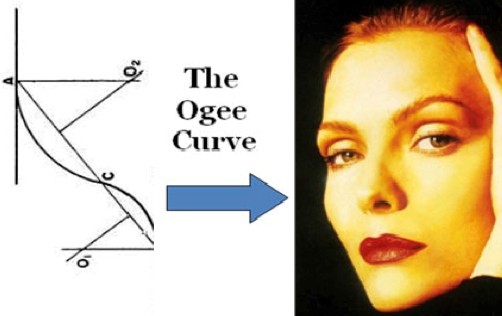Ogee (pronounced oh-jee)
(1) A
double curve, resembling the letter S, consisting of two arcs that curve in opposite directions
so that the ends are parallel. An ogee
is a kind of sigmoid curve, technically formed by the union of a concave and a
convex line.
(2) In
architecture, a molding with such a curve for a profile; cyma, also called
gula or talon.
(3) In
fluid mechanics, a specific aerodynamic profile.
(4) In
mathematics, an inflection point.
(5) In
cosmetic surgery, a desired shape for the curve of the malar or cheekbone
prominence transitioning into the mid-cheek hollow.
(6) In distillation,
the bubble-shaped chamber of a pot still connecting the swan neck to the pot which
allows distillate to expand, condense and fall back into the pot.
1275-1325: From the Middle English ogeus (plural oggez), ogeve, egeve & egeove, variants by assimilation from the French oggif (diagonal rib of a vault) from the Old French œgive, ogival, ogive & augive, from the Late Latin augiva of uncertain origin. In the Late Latin there was ogis (a support, prop), thought derived from the Classical Latin augeō (to increase, strengthen) from which Spanish gained auge (highest point of power or fortune; apogee); a doublet of ogive. The use in architecture to describe regular & irregular S-shaped moldings began in the 1670s, supplanting the earlier augive, from the Late Latin augiva of uncertain origin but perhaps related to the Latin via (way; road). In the Middle English, the late thirteenth century ogif was "a stone for the diagonal rib of a vault", derived from the French and the Medieval Latin ogiva.
An Ogee arch.
An ogee is a curved shape vaguely like an “S”, consisting of two arcs that curve in opposite senses, so that the ends are tangential. In architecture, it’s used to describe a molding with a profile made by a lower concave arc flowing into a convex arc. Used first in Persian and Greek architecture from Antiquity, it’s most familiar now as a part of the Gothic style. Because the upper curves of the ogee arch are reversed, it’s not suitable where the load-bearing rates are high and it’s thus used mostly in self-supporting structures exposed to their own weight and not subject to high external forces.
An inflection point.
In mathematics, an ogee is an inflection point, a point on a curve at which the sign of the curvature (ie the concavity) changes; inflection points may be stationary but are neither local maxima nor local minima. Inflection Points merely mark the point on the curve where it changes from concave upward to concave downward (or vice versa), it is not a directional measure. Calculus is needed to find where a curve goes from concave upward to concave downward and for this mathematicians use derivatives, one which determines the slope and a second which defines whether the slope increases or decreases.
The cosmetic surgeon's template.
When cosmetic surgeons speak of the ogee curve, they’re referring to the elongated S curve which, when looking at a patient’s face at a three-quarter aspect, describes the curve from the eye through the cheek down to below the cheek (technically the malar or cheekbone prominence transitioning into the mid-cheek hollow). As people age, the face loses volume in our face and the ogee curve flattens out. With facelifts and related procedures, the cosmetic surgeon aims to create an ogee curve, restoring the chiseled refinement of youth.
Lindsay Lohan, Cosmopolitan, October 2022 edition (photographs by Ellen Von Unwerth (b 1954)). The photographs illustrate the ideal ogee curve in the facial structure and Ms Lohan shows how a model's pout can be used to optimize the effect. The car is a second generation AMC Javelin (1971-1974).
Shapes derived from the ogee curve are popular design motifs used for just about everything where they can be applied but it's most associated with large, flat surfaces because it's in such spaces the geometric repetition can be most effective, thus the prevalence in fabrics, wallpaper and floor-coverings. The mind visualizes the shape as something like a two-headed onion and it's probably the association with the architectural style so often seen on mosques or other structures in the Arab world that in there's presumed to be some Islamic influence but ogee long pre-dates Islam. There are few conventions of use except that the designs tend to be displayed in either a horizontal or vertical aspect; diagonal deployment is rare.
In fluid mechanics, the ogee describes the shape used to create certain aerodynamic profiles, the classic example being the delta wing of the Concorde airplane. The ogee-type wing used on the Concorde one flavor of the compound delta (sometimes called double delta or cranked arrow) where the leading edge is not straight. Typically the inboard section has increased sweepback, creating a controlled high-lift vortex without the need for a foreplane and the shape of the sweepback is defined by the parameters of the ogee. On the Concorde, the two sections and cropped wingtip merge into a smooth ogee curve.






No comments:
Post a Comment